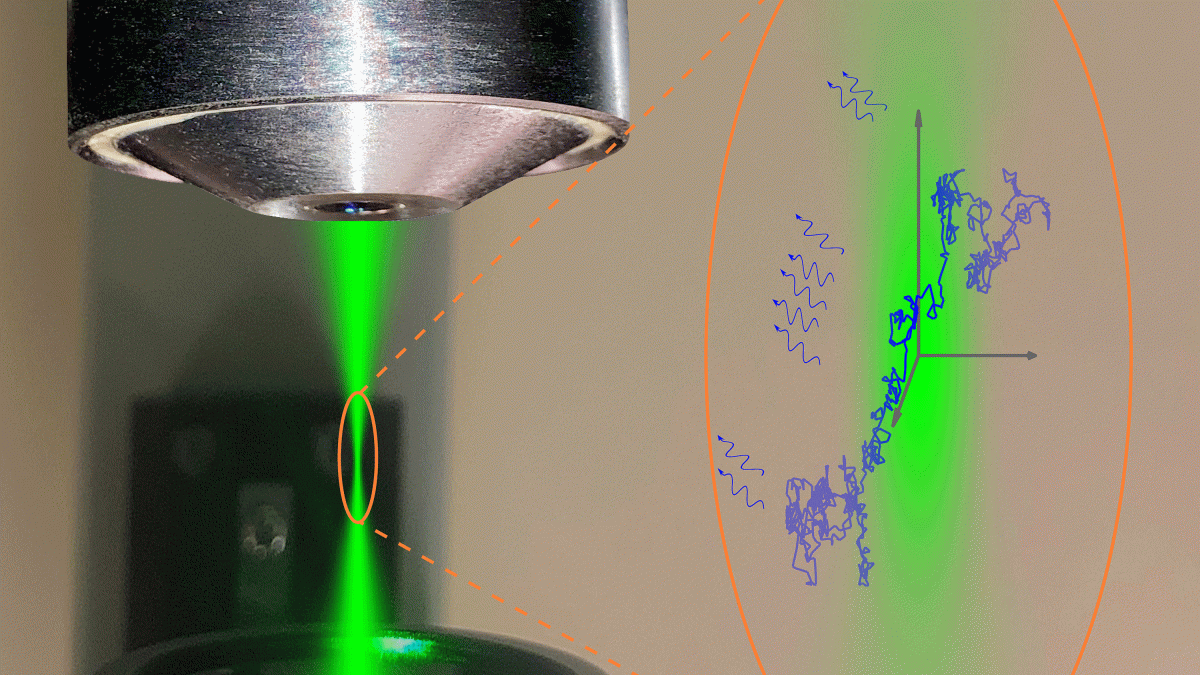Collecting light: ASU researchers publish faster methods for observing molecular behavior

Individual molecules are monitored using a tightly focused laser beam to illuminate molecules as they travel across its path. Photo courtesy of Meysam Tavakoli.
We live in a data-driven world. Thanks to the ever-connected climate made possible by the internet and mobile personal devices, we are both creators and insatiable consumers of information. What’s more, thanks to the capabilities of modern data processing and the current demand for an individual and customized experience, an incredible amount of time and energy is devoted to tracking, understanding, and predicting everything from shopping habits to weather patterns to viral twitter feeds.
So is it any wonder that physicists and biologists are finding inspiration in these same tools to unravel some of life’s most important questions?
While there are plenty of elements that come together to form what we think of as “life,” on a fundamental biophysical level, life happens one molecule at a time. Chemical reactions, replication of DNA, communication between molecules within a cell, this is where it happens, and we watch it unfold in real-time.
While we may not be quite there yet, new research developed by scientists from Arizona State University, Indiana University – Purdue University Indianapolis (IUPUI), and the University of California, Davis brings us a step closer. In a paper published in Physical Review X, ASU Associate Professor Steve Pressé and IUPUI graduate student Meysam Tavakoli, as well as other collaborators, draw on mathematical methods not typically seen in the natural sciences to create a faster modeling system to learn about the motion of molecules.
Capturing a snapshot
One traditional method of monitoring molecules in motion is a process called fluorescence correlation spectroscopy. This technique employs a tightly focused laser beam to illuminate fluorescent molecules as they travel across the beam, and extrapolates information about these molecules' movement and location from large quantities of data gathered over an extended time period – often as long as 10 minutes.
While this widely used method has provided valuable insight into the workings of many molecular processes, it is not without limitations.
The process takes a significant amount of time since it requires a large quantity of data to analyze. The results reflect averages of a “downsampled” measurement, similar to a representative sample in a poll or a census.
While analyzing averages sheds light on a topic or question, it can also paint a limited — or even — picture of real life, failing to represent refined depictions of distance, time or individuality.
To provide an example, Pressé suggested imagining you were trying to learn about a person’s location, and this person lived on one coast while making frequent visits to family members on another coast. The “average” location across an extended period might place them somewhere in between — a location that would tell you almost nothing about how this person lives or spends their time, nor would it enable you to say where that person was at any given time.
Therefore, the question becomes, how do we gather and process data in a way that provides us with more timely information? Monitoring individual molecule behaviors presents a similar challenge.
New math for a new problem
Rather than broad snapshots over time, Pressé and his team are expanding the capabilities of the traditional fluorescence correlation spectroscopy method by employing new mathematical tools.
Using photon detectors that report on photons emitted from single molecules within milliseconds, researchers interpret these detections using data-analysis techniques inspired by a statistical modeling tool called Bayesian nonparametrics. Their analysis can reveal an observational model with considerably less data than traditional methods.
The ability to collect and analyze near-immediate feedback could allow the observation and study of chemical reactions and other molecular processes that take place on a faster time scale than we have previously been able to record. Moreover, because more information can be gathered in a dramatically shorter period, the span of the overall experiment can be likewise shortened. This could reduce the toxic effect of prolonged laser-exposure of the molecular samples under study, particularly valuable when examining living cells.
New techniques and mathematics excite the possibility of unlocking further mysteries as the method continues to develop.
“Looking at the behavior of individual molecules from single-photon arrival could potentially be used to understand the interaction between many different molecules, and more complex reactions,” Pressé said.
The collaborators and co-authors of the paper are Meysam Tavakoli, graduate student, Indiana University – Purdue University Indianapolis’ Department of Physics; Sina Jazani, graduate student, ASU Center for Biological Physics; Ioannis Sgouralis, postdoctoral associate, ASU Center for Biological Physics; Omer M. Shafraz, graduate student, University of California, Davis’ Department of Biomedical Engineering; Sanjeevi Sivasankar, associate professor, University of California, Davis’ Department of Biomedical Engineering; Bryan Donaphon, instructor, ASU New College; Marcia Levitus, ASU associate professor, School of Molecular Sciences and Biodesign Institute; and Steve Pressé, ASU associate professor, Department of Physics and School of Molecular Sciences.
More Science and technology

The science behind chronic stress
Stress comes in many shapes and sizes. There’s the everyday stress of preparing for a final exam or being stuck in traffic. And…

ASU planetary scientist to be inducted into the National Academy of Sciences
The National Academy of Sciences is inducting School of Earth and Space Exploration Director Meenakshi Wadhwa into the 2023 class…

Unlocking the potential of AI for homeland security
“Can we do what we're doing now cheaper, more efficiently, more effectively?” Adam Cox, director in the Office of Strategy and…